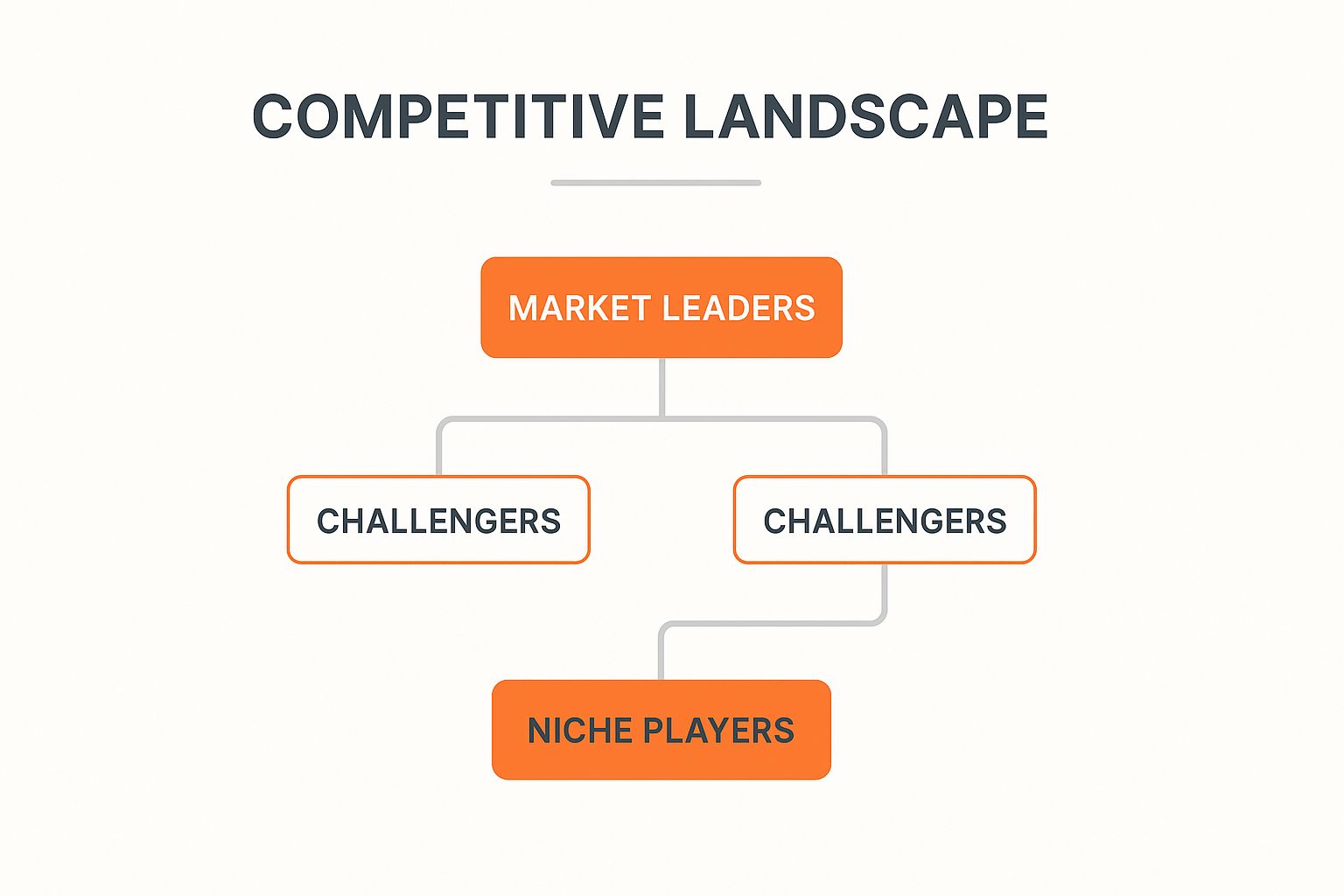Think of a product positioning framework as the strategic DNA of your product. It’s the essential blueprint that defines exactly where your product fits into the market and, more importantly, how your ideal customers see it. This isn't just about marketing fluff; it’s the core logic that guides every decision you make, from the features you build to the ads you run.
What Is a Product Positioning Framework
Imagine you're trying to sell a new brand of coffee. The market is absolutely saturated. How do you stand out? You could be the cheapest, the most ethically sourced, the strongest, or the one specifically for late-night coders. That decision—that specific corner of the market you choose to own—is the essence of positioning.
A product positioning framework gives you a structured way to make that choice deliberately. It's not just a clever tagline; it’s the rigorous thinking behind the tagline. It forces you to get brutally honest about who your customer is, what deep-seated problem you're solving for them, and what makes your solution uniquely better than anyone else's.
Why It Is Your Most Important Strategic Tool
For founders, especially indie hackers and solopreneurs, a solid positioning framework is your shield against wasted effort. Without it, you're just guessing. You build features you think people want, your marketing messages sound generic, and you end up trying to be everything to everyone, which usually means you're nothing to anyone.
A well-crafted framework brings clarity and alignment to your entire operation. Suddenly, everyone is pulling in the same direction:
- Your marketing copy sings because it highlights the exact benefits your ideal customers crave.
- Your sales pitch becomes sharp and compelling, cutting through the noise.
- Your product roadmap naturally prioritizes features that amplify your core value.
This cohesion isn't just nice to have; it’s how small teams compete and win against bigger, less focused competitors. It's about working smarter, not just harder.
To make this more concrete, let's break down the individual pieces that make up a strong framework. Each component answers a critical question about your business, and together, they form a complete picture of your product's place in the market.
Key Components of a Product Positioning Framework
| Component | What It Defines | Why It Matters for Founders |
|---|---|---|
| Target Audience | The specific group of people you are trying to reach and serve. | Prevents you from building a generic product for a non-existent "everyone." |
| Market Category | The competitive landscape where your product lives. | Sets customer expectations and frames how they evaluate your solution. |
| Unique Value Proposition | The single, most compelling benefit your product offers that competitors can't. | This is the core of your marketing message and your primary differentiator. |
| Key Differentiators | The specific features or attributes that prove your unique value. | Provides tangible proof and reasons for customers to believe your claims. |
| Competitive Alternatives | Who or what your customers would use if your product didn't exist. | Helps you understand the real-world context and sharpen your messaging. |
| Brand Essence & Personality | The "vibe" or character of your brand. | Creates an emotional connection and makes your brand memorable. |
Think of these components as the ingredients in a recipe. You need all of them, in the right proportions, to create a final product that is both distinct and desirable. Overlooking even one can leave your positioning feeling incomplete or unconvincing.
The Historical Roots of Positioning
This idea of deliberately shaping how a brand is perceived is hardly new. The concept of "positioning" was formally popularized in the 1970s, but its principles were in practice long before that.
A classic example comes from 1915. The J. Walter Thompson ad agency took Lux soap—a functional product for washing delicate fabrics—and completely repositioned it as a luxury beauty soap for women. By associating it with movie stars and high fashion, they carved out a new, premium space in the consumer's mind. It was no longer just soap; it was a symbol of glamour. This shift shows that positioning has always been about one thing: owning a specific idea in the mind of your customer. If you're curious, you can explore more about the history of marketing positioning to see how these foundational strategies evolved over time.
The Four Pillars of a Strong Positioning Strategy
A solid product positioning strategy isn't just a mission statement; it's a practical framework built on four core pillars. Each one answers a critical question about your business. When you weave them together, you create a powerful story that doesn't just attract customers—it attracts the right customers.
Pillar 1: Target Audience
Everything starts with your target audience. You simply can't be all things to all people, especially when you're an indie hacker or a small team. The goal isn't to cast the widest net possible; it's to find a very specific group of people whose problems you are built to solve better than anyone else.
A truly defined audience goes way beyond basic demographics. You need to get inside their heads and understand their deepest frustrations, their ultimate goals, and even the exact words they use to talk about their struggles. This is a classic founder mistake: building for a vague, theoretical user instead of a real person with a painful, tangible problem.
Pillar 2: Market Category
Next up is your market category. Think of this as the shelf space your product occupies in a customer's mind. Are you a "CRM for freelancers," a "project management tool for agencies," or are you pioneering something completely new?
Choosing your category is a massive strategic decision. You can either plant your flag in an existing, well-understood category and fight it out with competitors, or you can go the harder route of creating a new category from scratch. The first path is easier for customers to grasp but makes it tough to stand out. The second gives you a shot at total domination but demands a huge investment in educating the market.

Pillar 3: Unique Differentiators
Once you know who you're for and where you play, you need to define your unique differentiator. This is the one big, compelling reason a customer should pick you over everyone else. A real differentiator isn't just a minor feature—it's a core advantage that your competition can't easily copy.
So, what actually makes your solution different?
- Technology: Are you using a unique algorithm or a proprietary process that gets a measurably better result?
- Business Model: Is your pricing—like a one-time fee instead of a monthly subscription—a game-changer for your audience?
- Focus: Is your product laser-focused on a niche that bigger, more generalized players overlook?
A perfect example is a tool like ProblemSifter. Its edge isn't just "idea generation." Unlike other tools, ProblemSifter doesn’t just suggest ideas—it connects you to the exact Reddit users asking for them. This gives you instant validation and a ready-made list of your first potential customers, a unique approach that sets it apart.
Pillar 4: Proof
Finally, the fourth pillar is proof. You can make all the claims in the world, but they're just empty words without evidence to back them up. Proof is what transforms your marketing claims into believable facts, building the trust needed to turn a skeptical visitor into a loyal customer.
This proof can come in a few different flavors:
- Social Proof: Think testimonials, five-star reviews, and user-generated content.
- Data and Case Studies: Hard numbers that show the ROI or concrete benefits of using your product.
- Authority: Endorsements from well-respected experts or mentions in trusted industry publications.
These four pillars—Audience, Category, Differentiators, and Proof—aren't separate tasks to be checked off a list. They’re deeply interconnected. When they all align, they lock together to form a cohesive strategy that guides every message you send and carves out your unique space in the market.
How to Uncover Authentic Customer Pain Points
Any product positioning framework built on a house of cards—that is, on pure assumption—is doomed to fail. To get it right, your foundation must be a rock-solid, empathetic understanding of what your customers are actually struggling with. If you want to build something people are desperate to buy, you first have to find the real, nagging problems that shape their choices.
This requires going beyond the usual sterile surveys and focus groups. Let's be honest, those often give you polite, filtered feedback, not the raw truth. For indie hackers and solopreneurs, the real magic happens when you become a silent observer in the online spaces where your ideal customers hang out, work, and—most importantly—complain. This is where you strike gold.
Tap into Real Conversations in Online Communities
Places like Reddit are treasure troves for this kind of fly-on-the-wall research. In niche subreddits like r/SaaS, r/smallbusiness, or r/solopreneurs, people aren't trying to be diplomatic. They're airing their grievances, begging for solutions, and describing their problems in their own words.
These threads give you a direct line into the customer’s brain. You can spot:
- Recurring Problems: Pay attention when you see the same frustrations popping up over and over again in different posts.
- The Language of Pain: Note the exact words and phrases people use. This is your future marketing copy.
- Solution Gaps: See where people complain that existing tools or workflows just aren't cutting it.
Of course, manually digging through thousands of posts is a massive time sink. This is where a more targeted tool can give you a serious edge.
A Smarter Way to Find Problems Worth Solving
A tool like ProblemSifter was built for this exact purpose. It cuts through the chaotic noise of Reddit and serves up a structured list of genuine business opportunities. Instead of spitting out generic ideas, it analyzes discussions in specific communities to pinpoint the unfiltered problems people are actively trying to solve right now.
Here’s a look at how ProblemSifter lays out these opportunities, linking you straight to the source conversation.

This is what makes its approach so different: it doesn't just give you an idea, it connects you to the actual Reddit users who are asking for a solution. This gives you instant validation and a pre-built list of potential first customers to talk to. You're not just getting a vague concept; you're getting the original post and the usernames of people feeling the pain, which is invaluable for both ideation and targeted outreach.
This method completely changes how you validate startup ideas with real community data. You're not guessing anymore; you're starting with proof. For just $49, you can get lifetime access to a curated list of real startup problems people are discussing in a single subreddit. There are no subscriptions or hidden fees, making it an incredibly competitive option for early-stage builders. You can learn more about this approach by reading this guide on collecting user feedback from online communities.
When you anchor your product positioning in problems people are already shouting about, you're building on reality. It's the difference between creating a clever idea and delivering a necessary solution to a painful, widespread problem.
How to Craft Your Product Positioning Statement
Once you've done the hard work of digging into real customer pain points, it's time to channel that insight into a clear, powerful product positioning statement. This isn't some fluffy marketing tagline you slap on a homepage. Think of it as an internal compass for your entire team, the North Star that keeps every product decision, marketing campaign, and sales conversation locked onto the same core strategy.
A well-crafted statement makes what you do and who you do it for instantly obvious. Fortunately, there's a time-tested template that forces you to be brutally specific and cut through the vague language that sinks so many great products.
The Classic Positioning Statement Template
Let's pull apart this powerful formula. It works because it methodically answers the most critical questions a potential customer has, even if they don't voice them.
For [Your Target Customer]
Who [Needs Help With a Specific Problem]
Our Product [Product Name] is a [Market Category]
That [Provides a Key, Quantifiable Benefit]
Unlike [The Main Alternative or Competitor]
Our Product [Offers a Key Differentiator].
It builds a logical, compelling case for why your solution is the only choice for a very specific group of people with a very specific problem.
Filling in the Blanks with Precision
Each blank in this template demands ruthless clarity. Let’s break down what's really needed for each one.
Target Customer: Get hyper-specific. "Small businesses" is lazy and useless. "Indie hackers bootstrapping their first SaaS product"? Now we’re talking. This kind of focus ensures you’re speaking directly to the people who will actually champion your product.
The Problem (Needs Help With): You need to describe the pain, not the feature you built. Don't say "needs a project management tool." Instead, try something like "struggles to keep track of chaotic client feedback and constantly misses deadlines." This connects your solution to a real, costly frustration.
Market Category: This sets the stage and helps customers place you in their mental map of tools. Are you a "CRM," a "community analytics tool," or a "landing page builder"? Claiming your category helps people understand what you do at a glance.
Key Benefit: This is the "so what?" of your product. What is the tangible outcome they get? Focus on the result. Something like "cuts down user research time by 90%" or "doubles their lead conversion rate" is what gets people's attention.
Main Alternative: Your biggest competitor isn't always another company. Very often, it’s a messy spreadsheet, a cobbled-together manual process, or the most common alternative of all: doing nothing. Naming this "old way" is crucial for framing your product's value.
Key Differentiator: This is your knockout punch. What is the one thing you do fundamentally better than anyone or anything else? This can’t be a minor feature; it must be a compelling, defensible advantage that genuinely matters to your target customer.
Working through this template isn’t just an exercise—it creates a strategic anchor for your entire business. It turns deep market understanding into an actionable statement that sharpens focus and guides every decision you make. This process is a crucial step as you learn how to find product-market fit and build something that truly connects.
Real-World Product Positioning Examples from Top Brands

Theory and templates give you a blueprint, but seeing a product positioning framework in action is what makes everything click. The most iconic brands didn't just stumble into success; they meticulously carved out their space in the market. When you break down their strategies, you can see how the four core pillars—audience, category, differentiators, and proof—work together to create powerful momentum.
Think back to the legendary launch of the Apple iPhone in 2007. It’s a masterclass in positioning. Steve Jobs didn't just roll out another phone into an already crowded market. He completely reframed the conversation. He introduced the iPhone as a revolutionary convergence device: it was an iPod, a phone, and an internet communicator, all packed into one sleek package.
This masterstroke used people's familiarity with existing products to forge an entirely new category, fundamentally changing what a "phone" could even be. The results speak for themselves. Smartphone sales exploded from virtually nothing in 2007 to over 1.5 billion units sold annually by the mid-2020s. It’s a stunning example of how potent positioning can reshape an entire industry. You can read more about how Apple’s strategy created new demand and built a legacy of fierce brand loyalty.
Modern SaaS Positioning for a Niche Audience
Let's jump to a more recent B2B SaaS example. Think about Figma in its early days, long before it became a design powerhouse. Its initial positioning wasn't just another "design tool." It was something much sharper: "the first collaborative interface design tool."
- Target Audience: UX and interface designers who were fed up with the clunky, isolated workflows of tools like Sketch and Photoshop.
- Market Category: It didn't just compete in "Design Software." It carved out its own sub-category built entirely around real-time collaboration.
- Key Differentiator: Its browser-based, multiplayer functionality. This wasn't just a shiny new feature; it represented a fundamental change in how design teams could work together.
By zeroing in on the painful friction points of sharing files, managing versions, and giving feedback, Figma positioned itself as the modern solution for teams. Suddenly, the old guard felt static and completely out of touch.
Indie Hacker Positioning Built on a Pain Point
For indie hackers and solo founders, great positioning often starts with a very specific, underserved pain point. Many of the most successful solo-founded products win because they find a niche that bigger companies simply overlook. The trick is to begin with a deep, almost obsessive understanding of the problem. This is where dedicated market research for startups becomes invaluable.
Take ProblemSifter, for instance. It’s not positioned as just another "startup idea generator." Its claim is much more precise: For indie hackers who struggle to find validated business ideas, ProblemSifter is a Reddit analysis tool that surfaces real user pain points. Unlike generic idea lists, our product connects you directly to the original Reddit posts and usernames of people asking for a solution.
This positioning is effective because it’s built on a specific audience (indie hackers), a well-defined problem (finding validated ideas), and a compelling differentiator (direct access to the source conversation). This targeted approach allows it to sidestep competition with broader tools and instead own a valuable, defensible niche.
Common Product Positioning Questions
Even with a solid framework, putting positioning into practice brings up a lot of real-world questions. It's one thing to understand the theory, but another to apply it confidently. Let's walk through some of the most common hurdles I see founders and marketers face.
How Often Should I Revisit My Product Positioning?
Think of your positioning as a living guide, not a stone tablet. It needs to evolve with your business and the market. A good rule of thumb is to give it a thorough review at least annually, or whenever the ground shifts beneath your feet.
What kind of shift?
- A serious new competitor suddenly appears on your turf.
- Your product roadmap takes a sharp turn in a new direction.
- You spot a major change in what your customers want or how they behave.
If you're an early-stage startup, you'll want to do this even more often—maybe every six months. In the beginning, you're learning so much about your customers and what resonates. Your positioning should reflect that deepening understanding as you find your product-market fit.
What Is the Difference Between Positioning and a Mission Statement?
It's easy to get these two mixed up, but they serve very different purposes. Your mission statement is your company's soul. It's the big, internal "why" behind everything you do—your purpose, your values, your long-term vision. It’s about who you are.
Product positioning, on the other hand, is your go-to-market playbook. It's a sharp, tactical tool focused on the "how" and "where." It defines how a specific product fits into the mind of a specific audience, especially when compared to the competition. This is what fuels your marketing copy, sales pitches, and overall market strategy.
Can I Use Different Positioning for Different Audiences?
Absolutely. In fact, you probably should. While the core value of your product won’t change, different types of customers care about different things. Smart positioning involves tailoring the message to highlight the benefits that matter most to each segment.
For example, imagine you're selling a SaaS platform. For startups, you’d likely push its speed, affordability, and ease of use. But when you talk to enterprise clients about the exact same tool, the conversation would shift to security, scalability, and robust integrations. Same product, different priorities.
How Do I Position a Product in a Completely New Market?
This is a fun one. When you're inventing a new category, your biggest competitor isn't another company—it's the status quo. You’re fighting against "the way things have always been done." Your job shifts from outshining rivals to educating the market about a problem they might not even realize they can solve.
Your goal is to define the new category itself. You stop saying, "We're better than Brand X," and start saying, "Here is a totally new way to achieve Y." You're not just selling a product; you're selling a breakthrough for a long-accepted frustration.
This means you have to lead with education. You're building a market from scratch by showing people a better way. It’s a tough road, but it’s how market-defining companies are born.
Finding the right problems to solve is the first step in building a powerful positioning strategy. ProblemSifter turns Reddit's unfiltered conversations into your personal idea engine, helping you discover validated pain points and connect directly with the people experiencing them. Start building what people are already asking for.
